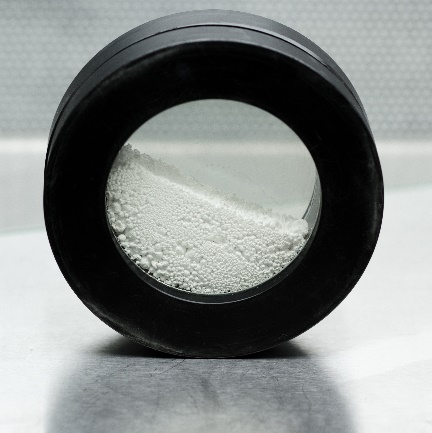Blog
The Importance Of Powder Flow Characterization
Powder flow, also known as flowability, is defined as the relative movement of a bulk of particles among neighboring particles or along the container wall surface. In other words, powder flowability refers to the ability of a powder to flow in a desired manner in a specific piece of equipment...
'The success or failure of a product relies on the powder flow behavior during manufacturing.'
What Is Powder Flow?
Powder flow, also known as flowability, is defined as the relative movement of a bulk of particles among neighboring particles or along the container wall surface [1].
In other words, powder flowability refers to the ability of a powder to flow in a desired manner in a specific piece of equipment [2].
Powder flow is thus a multidimensional problem where powder characteristics are studied in conjunction with the geometry of an application to predict flowability [3].
Why Characterizing Powder Flow?
To achieve better manufacturing efficiency and product quality in powder processing industries, a predictable powder flow is of greater importance to avoid capacity shortfall and production interruption that involve costly loss of production time. For example, food industry makes extensive use of vertical bins or silos for powder storage. Irregular flow of powders out of those is a major cause of loss in production capacity and product deterioration [4].
In pharmaceutical industry, powder flow behavior can affect manufacturing efficiency, which can directly affect the product quality in terms of its weight and content uniformity [4, 5].
In powder bed fusion additive manufacturing, powder flow directly affects the layer generation capabilities and thus the quality of the final part.
Therefore, gaining valuable insights into powder flow characterization by testing flow properties is essential to avoid flow problems on production lines, optimize industrial processes and ensure that consistent output is maintained.
How To Characterize Powder Flow
Due to its multidimensional aspect, the powder flow cannot be expressed as a singlevalue or index extracted from one simple test method. Thereby, multiple characterization approaches should be considered reflecting the application field and the process conditions. The closer the characterization method comes to the actual process conditions, the clearer the relationship to the final product property will be.
Six methods are commonly reported to measure powder flowability: angle of repose, compressibility index or Hausner ratio, flow in a rotating drum and through an orifice, shear cell, and rheometers for powder [6]. To overcome the poor accuracy and the low reproducibility of those methods, GranuTools has revisited some of them by automatizing the measurement process. In particular, GranuTools has developed optimized application-oriented instruments. They are easy to use and sensitive and lead to reproducible user-independent measurements. Furthermore, GranuTools has given specific attention to implement measuring methods that lead to meaningful results, easily interpretable and easily usable to improve industrial process.
Amongst GranuTools instruments, GranuDrum, GranuFlow, and GranuCharge provide a powerful toolkit for the analysis of powders dynamic properties and the characterization of the powder flow for applications ranging from additive manufacturing to food processing industries.

The GranuDrum is an automated powder flowability measurement method based on the rotating drum principle. In this method, the powder flow is accurately analyzed at the air/powder interface without any compressive load. Measurements of the interface and its fluctuations are used to compute the flowing angle and the dynamic cohesive index.
LEARN MORE ABOUT THE GRANUDRUM
The rotating drum geometry is appropriate for applications in additive manufacturing and pneumatic conveying characterized by high shear and low-pressure constraints. It allows to detect flow problems before the powder is introduced in the processing equipment. Moreover, it is a perfect tool to quantify powder spreadability, which plays a key role during a recoater process in additive manufacturing.

LEARN MORE ABOUT THE GRANUFLOW
The GranuFlow is a simple powder flowability measurement device composed of a silo with diverse apertures linked to a dedicated electronic balance to measure the mass flow rate of powders. This one is automatically calculated from the slope of the mass temporal evolution determined with the balance.
The funnel or silo configuration is a common approach for powder feeding in food and pharma industries, where powder bridging and powder segregation must be avoided to ensure consistent flow rates. Indeed, powder segregation during processing and storage may result in poor flow, a buildup of powder residue, and problems with stock handling and filling and packing operation.

LEARN MORE ABOUT THE GRANUHEAP
The GranuCharge is the first instrument that measures the ability of a powder to produce electrostatic charges while flowing inside a tube of a chosen material [7].
The presence of electric charges in a powder induces cohesive forces, resulting in the formation of agglomerates and thus in poor powder flow. Therefore, GranuCharge is able to predict the flowability deterioration during processing. It is of particular interest to improve pneumatic vacuum conveying process and during the layer formation in additive manufacturing, for examples.
LEARN MORE ABOUT THE GRANUCHARGE
GranuTools is constantly looking for optimizing powder characterization methods in order to be as close as possible to the application and ensure the pertinence of the results.
References
1] M. Peleg, “Flowability of food powders and methods for its evaluation – A review”¸ J. of Food Process Engineering (1977) 303-328.
[2] J.K. Prescott and R.A. Barnum, “On powder flowability”, Pharmaceutical Technology 24 (10): 60-84. (2000)
[3] A.T. Sutton et al., “Powder characterisation techniques and effects of powder characteristics on part properties in powder-bed fusion processes”, Virtual and Physical Prototyping 12: 3-29 (2017)
[4] Bulk Properties. In: Food Powders. Food Engineering Series. Springer, Boston, MA (2005)
[5] G. Lumay et al., “Influence of mesoporous silica on powder flow and electrostatic properties on short and long term”, J. of Drug Delivery Science and Technology 53: 101192 (2019)
[6] G. Lumay et al., “Measuring the flowing properties of powders and grains”, Powder Technology 224: 19-27 (2012)
[7] A. Rescaglio, “Tribo-electrification of pharmaceutical powder blends”, Particulate Science and Technology 1533606 (2018).
